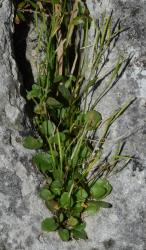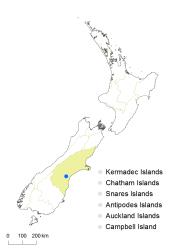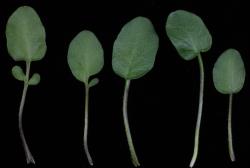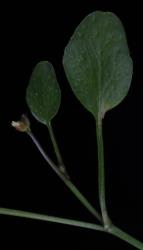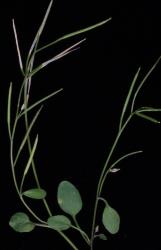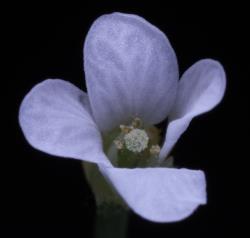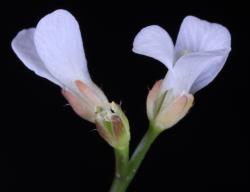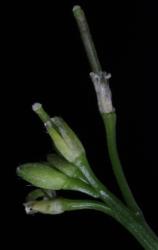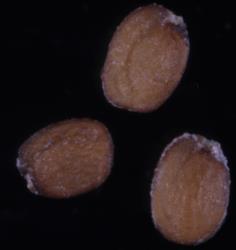Perennial herb, single rosette or with short lateral branches. Leaves up to 70 mm long, usually simple, seldom pinnatifid or pinnatisect; lamina 2.5–19.0 × 2.0–11.0 mm, green, membranous, glabrous on abaxial surface, glabrous or occasionally with hairs on adaxial surface, glabrous or sparsely hairy to glabrescent on margin and petiole; hairs 0.2–0.25 mm long, spreading to patent; petiole up to 50 mm long. Terminal pinna 2.5–19.0 × 2.0–11.0 mm, simple, oblong-elliptic, broadly oblong-elliptic, to oblong-orbicular; margin entire to shallowly crenate, with 2–4 indistinct hydathodes; apex obtuse with a usually indistinct hydathode; base cuneate to occasionally obtuse. Lateral pinnae absent or 1–2, 2.0–5.0 × 1.5–3.2 mm, broadly oblong-elliptic to oblong-orbicular; apex obtuse; base often oblique; sessile or petiolule < 0.5 mm long. Cauline leaves similar to rosette leaves but smaller, narrower, with no lateral pinnae; terminal pinna up to 18.0 × 10.0 mm, oblong-elliptic, narrowly oblong-orbicular. Inflorescence with 1–8 corymbs, each corymb 2–4-flowered or flowers sometimes solitary; peduncle up to 150 mm long, 0.5–1.0 mm diam. at base, spreading to weakly ascending, glabrous. Pedicels 6.0–42.0 mm long, 0.25–0.5 mm diam., glabrous. Sepals 1.8–2.5 × 0.4–1.0 mm, oblong, elliptic-oblong, saccate, green, sparsely hairy, hairs spreading to patent, margin white and membranous, apex obtuse, base truncate. Petals 4.5–6.0 × 1.8–2.0 mm, white, limb obovate; apex obtuse; base attenuate, tapering to a 1.0–1.2 mm long claw. Stamens 6; median filaments 4, 1.6–2.2 mm long; lateral filaments 2, 1.5–1.8 mm long; anthers 0.5–0.6 mm long, cream to pale yellow, when dehiscent held at a similar height to or slightly below the stigma. Ovary 2.5–3.5 mm long, 0.4–0.5 mm diam., ± terete, green, glabrous; ovules 20–34; style c. 0.4–0.5 mm long, ± terete; stigma 0.3–0.4 mm diam. Siliques 9.0–20.0 × 0.9–1.1 mm, glabrous, style 0.5–1.4 mm long; valves green to yellow-green at maturity and when dehiscent; replum 0.3–0.4 mm wide. Seeds 0.8–0.9 mm long, 0.5–0.6 mm wide, 0.25–0.35 mm thick, oblong to broadly oblong, henna-green to henna; wing absent.
Cardamine integra is distinguished from C. corymbosa by the rosette leaves being mostly simple and having a cuneate to occasionally obtuse base, and the cauline leaves being simple and oblong-elliptic to narrowly oblong-orbicular. Cardamine grandiscapa is also found on the limestone bluffs at Rockdale, but it occurs under shaded forest in south-facing gullies. These two species are most easily distinguished by C. integra having rosette and cauline leaves, mostly simple, oblong-elliptic, broadly oblong-elliptic to oblong-orbicular, and with a cuneate to occasionally obtuse base; C. grandiscapa has rosette and cauline leaves, usually pinnatisect, orbicular, orbicular-reniform to orbicular-deltoid, and an obtuse, truncate or cordate base.
South Island: Canterbury.
Known only from limestone bluffs at Rockdale, South Canterbury.
Cardamine integra is restricted to limestone habitats, where it occurs on ledges and in crevices on bluffs and rock outcrops.
Cardamine integra is assessed as having a conservation status of Threatened, Nationally Critical (A2), with the qualifier Data Poor (de Lange et al. 2018). The qualifier Data Poor is applied since there is other limestone habitat that may be suitable for the species in South Canterbury and further field survey is required.
Flowering September–February; Fruiting October–March.



